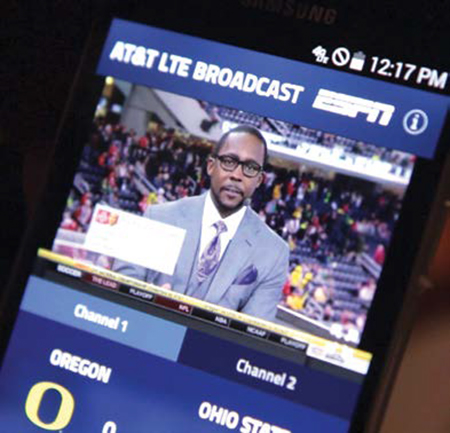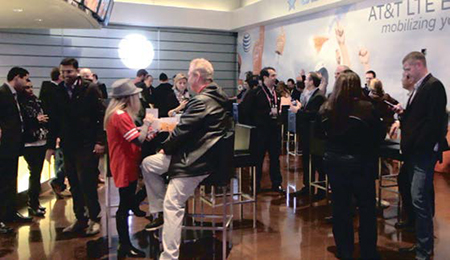AT&T Tests LTE Broadcast Tech at College Football Playoff

AT&T, Qualcomm and Samsung provided 40 specially modified Galaxy Note 3 LTE-broadcast enabled handsets for testing.
ARLINGTON, TEXAS—Ohio State University may have won the 2015 College Football Playoff National Championship, but AT&T scored big as well by offering its first demonstration of its LTE broadcast technology during the game at the AT&T Stadium in Arlington, Texas. The carrier, along with partner MobiTV, used AT&T’s 4G network to broadcast two ESPN video streams from the game to multiple devices simultaneously. This included replays from multiple angles and a data stream that featured constantly updated feeds of stats and trivia.
For the closed demonstration, AT&T worked with network supplier Ericsson to upgrade cellsites in and around the stadium, while AT&T, Qualcomm and Samsung provided a total of 40 specially modified Galaxy Note 3 LTE Broadcast-enabled handsets for testing. The handsets were modified with the necessary firmware to receive the multicast signal.
“We were pleased with the performance and the demonstration validated the technology worked well in a live environment just like we thought it would,” said Tom Keathley, senior vice president of wireless network architecture and design at AT&T. “The video quality was outstanding and the response from those who experienced it was very enthusiastic.” During the demo, AT&T reported using about 5 MHz of its LTE spectrum to deliver the video and data streams, with a streaming speed around 1 Mbps.
“The concept of LTE Broadcast relies on a proven business model: save bandwidth by getting multiple people to access the same bitstream,” said Steve Blum, a telecommunications industry analyst with Tellus Venture Associates in Marina, Calif. “It’s the same idea behind cable TV, for example, where you are taking one bitstream and deliver it to multiple people, as opposed to the standard mobile model where everyone has their own bitstream.”
HIGH BANDWIDTH CONTENT
While today’s 4G networks are already capable of delivering video content, LTE Broadcast could offer an advantage in that it is far more efficient to deliver high-bandwidth content to a larger number of people in the same place at the same time.
“There have been various attempts to try to do it on mobile platforms in the past—Qualcomm had such a venture a few years ago—but technology and demand weren’t there yet,” Blum told TV Technology. “There’s now sufficient demand and technology has caught up.”
Get the TV Tech Newsletter
The professional video industry's #1 source for news, trends and product and tech information. Sign up below.
This recent demonstration also followed mobile broadcasts by rival Verizon at last year’s Super Bowl. Football stadiums may be the perfect place to demonstrate this technology, but also a potential venue for where it could be best used. Large venues such as stadiums typically have been mobile “dead zones,” even in those that offer supposedly free Wi-Fi hotspots.
The reason is too many people are in one spot all trying to access content on their phones. LTE Broadcast, which is part of the LTE standard, could remedy this problem as it would be widely integrated into future smartphones and tablets.
“Multicast can reduce the chokepoints that we’ve been experiencing with traditional wireless networks over the past couple of years,” said Kerry Travilla, senior director of technology at MobiTV, an Emeryville, Calif.-based provider of mobile media technology and AT&T’s partner at the event.

AT&T’s demo of LTE Broadcast at the 2015 College Football Playoff National Championship was made available to a select group.BIG GAME, BIG DEMO
While AT&T opted to show off its technology in a controlled environment to a fairly small number of devices, it did so during a live event instead of as part of a canned demonstration utilizing a video-on-demand offering. This presented greater challenges, but helped show that the technology is indeed useable in these scenarios.
“Because we chose to do this not only at a live event, but at a very high profile, national event, there were some unique pressures our technical team worked through,” said Keathley.
“We had an accelerated timeline to get the network infrastructure and the connectivity to the content ready to go.” For AT&T this meant it was limited in live testing opportunities, yet conducted as much advance testing as possible. It helped that the demos could be done at AT&T Stadium, which is arguably one of the most technologically advanced venues in the country.
“We wanted to ensure the trial demonstration would not affect regular wireless traffic in the stadium, so we very closely tested and monitored that aspect of the trial,” Keathley said. “We had both live video streams and live stats, and because we are still developing some portions of the technology, we had to do a lot of fine tuning along the way.”
MASS ENTERTAINMENT
LTE Broadcast—which AT&T has said it plans to deploy sometime this year on the 700 MHz D and E spectrum it acquired from Qualcomm—is based upon evolved Multimedia Broadcast Multicast Service (eMBMS). Also known as “LTE Multicast,” it is notable in that it is designed to efficiently deliver content in a densely populated area, which it can allocate a portion of the LTE network resources to host specific content streams that any compatible device can access.
In this way it allows all compatible devices to receive the content simultaneously with optimized performance.
The rollout of this technology is also coming in advance of AT&T’s expected participation in next year’s auction of the broadcast spectrum. Blum says AT&T’s use of LTE shouldn’t affect the company’s plans for the auctions.
“Any spectrum AT&T may acquire would be repurposed for mobile use, but this particular technology shouldn’t have much of an impact on what AT&T actually does with that spectrum,” Blum said. “The more things the carriers look to do with their spectrum, the more spectrum they need.” LTE Broadcast won’t solve the growing demand for spectrum by the carriers, but it could remedy issues that users in dense areas experience when trying to access content on mobile devices.
“Without LTE Broadcast many customers attending a football game accessing venue-specific content could experience lags or buffering because everyone else is trying to get that same content, at the same time, through individual data streams for individual devices,” Keathley said. “LTE Broadcast would have one single data stream for the helmet cam footage, available to all compatible devices in the stadium, which could minimize network congestion.”The technology is thus suited to venues such as sports arenas and stadiums where it could even enhance the experience beyond what viewers at home might see.
“It could offer access to in-stadium camera views that aren’t on TV,” said MobiTV’s Travilla, who added that the 2015 CFB test showed what is possible. “Applying this ability to stream content to the masses was actually very easy. It is all about the technological plumbing that it had to go on. The recent game allowed us to demonstrate that we’re smart enough to know the future looks like and we’re ready for it.”
